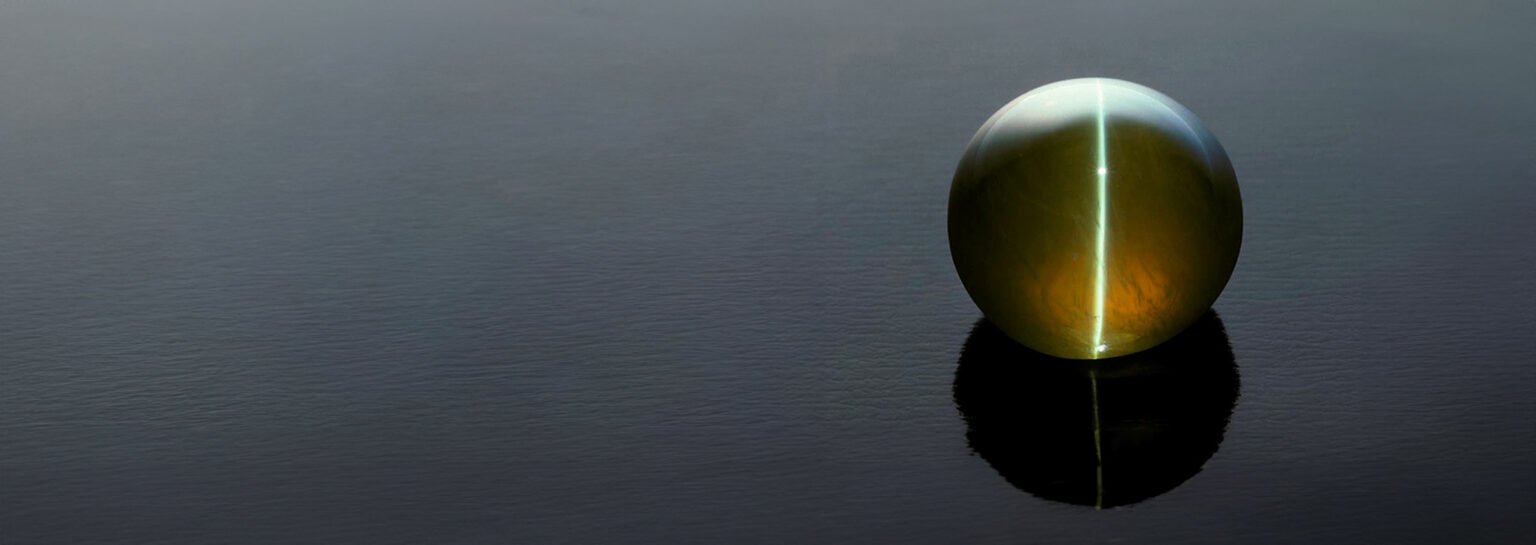Maybe it’s the translucent honey color. Maybe it’s the slit of reflected white light that intersects the stone lengthwise when cut in cabochon form.
But whatever is responsible, cat’s-eye chrysoberyl is a rare gem that is highly prized by men in this country and even more so by them in Japan. Indeed, says John Ramsey, Ramsey Gem Import Inc., San Diego, “Japanese demand is the reason why we don’t see finer cat’s-eye in smaller sizes in this country. The best stuff in sizes up to 5 carats goes to the Far East.”
Whether sent to Asia or brought here, cat’s-eye is used mostly in rings but also in men’s accessories such as cuff links or tie tacks. Dealers aren’t really sure why this gem has such masculine appeal. They simply assume that cat’s-eye chrysoberyl’s “milk-and-honey” appearance lends itself more to men. Affluent men.
“There’s just good and bad in cat’s-eye,” Ramsey explains, “and nothing in between. What’s more, the good is expensive—at least, in those 5-carat-plus sizes men in this country prefer.”
Once above 3 carats, prices for fine- to gem-grade cat’s-eye climb rapidly—due to increasing rarity in larger sizes. For instance, a truly exceptional 3-carat stone might cost a jeweler around $1,200 per carat while its 10-carat counterpart might cost $3,500 per carat.
That leaves American men pretty much confined to the 4- to 6-carat-size range where increasing rarity, voracious Far East demand and non-stop dollar declines have pushed the cost to jewelers for fine stones into the $1,800- to $2,200-per-carat range.
So the only options for those who want to spend less are either to downgrade to commercial quality, an option most rule out or search for smaller sizes, an option the Japanese rule out for Americans. Consequently, there is not much of a market in commercial cat’s-eye. Most consumers don’t want to settle for less when it comes to this gem.
The “Eyes” Have It
Fine cat’s-eye must have a combination of elements—color, chatoyancy, clarity, translucency and proportions—to make it truly distinctive. Because so many factors come into play when judging cat’s-eye, and few measure up in the final run, few but high-end jewelers get involved with this gem.
“You’ve got to develop a feel for cat’s-eye,” says lapidary Reggie Miller, Reginald C. Miller Inc., New York, “and that’s not always easy given the relative scarcity of fine material and the out-of-the-ordinary criteria by which it is judged.”
Unlike most gems, which depend on body color primarily to make it to connoisseur class, cat’s-eye has to excel in two areas: color and chatoyancy. Briefly, chatoyancy is a gemological special effect by which light reflected from very fine, densely packed rutile fibers is concentrated in a crisp line, reminiscent of the iris of a cat’s eye, along the dome top of a stone when it is cut in cabochon form.
Obviously, if the “eye” of such a stone depends on the hand of the cutter. If the cab is cut too flat, the eye will appear too wide, wavy and ill-defined. If cut too high, the eye might appear too thin. And if poorly proportioned, the eye may be off-center or run slightly diagonal instead of lengthwise.
In short, a good “eye” is one that is centered, sharp and straight—without being pencil-thin. Viewed on top under a single light source the eye should stay bright and defined as the stone is rotated in the hand. Ideally, the “eye” should be free of coloration from the stone’s background. Often, however, there is bleed-through that gives the eye a yellowish or greenish cast, depending on which color predominates. Such interference is considered a drawback in connoisseur circles.
Honey Brown and Apple Green
After chatoyancy comes color. Cat’s-eye runs a color range from raw honey-brown to apple green, with all sorts of mixtures in between. Although the men’s market tilts toward the rich yellow-browns, a slight hint of green is acceptable to some men while greener stones find favor with women.
“For the most part,” Miller says, “the honey colors come from Brazil, one of the two principal modern sources for cat’s-eye chrysoberyl. The other source, Sri Lanka, tends to produce more of the apple-green variety. However, the Sri Lankan stones tend to have more defined and silvery ‘eyes,’ as well as greater luster.”
Luster, partly a function of hardness which Miller says is greater in Sri Lankan stones, is also related to translucency, the degree to which light penetrates a stone. Cat’s-eye is a stone that should be neither opaque nor transparent. Opaque stones often lack the sensuousness of translucent stones while transparent and semi-transparent stones have overly watery color and dimmer, less defined “eyes.” In a properly translucent stone, says Richard Postrel, Gem Source Ltd., Bay Harbor, Fla., “the eye shines sharply with either a slightly milky-blue or silvery cast.”
When checking translucency also check clarity. This can be done, Postrel advises, by shining a penlight into the stone from the bottom to see just how included the dome may be. Lightly included stones are acceptable. Heavily included ones should be discounted or else disregarded.
Last, consider cutting. A stone should have a medium dome, one that is centered not lopsided. When viewed from the top, the “eye” should run the entire length of the stone. “Some eyes give out three quarters of the way,” Ramsey says, “because the rutile fibers that make the eye just aren’t there.”
When viewed from the side, the “eye” should appear to climb straight up the center of the stone from the base of its oval. One other thing: “Don’t be afraid of bottom-heavy stones,” Miller says. “You might think you are paying for needless weight. But the bottom adds depth to the appearance of both the stone’s ‘eye’ and color.”
One sure sign of a well-cut cat’s-eye is what the trade calls the “milk-and-honey” effect. To observe this effect, shine a penlight on the stone’s top as someone else steadies it horizontally overhead. If cut properly, the dome will divide into perfect halves of light and dark, separated by the eye. In honey-colored stones, the “milk-and-honey” effect can often be quite spectacular as the half hit by the light turns a brilliant white and the half in dark turns a deep, burnished brown.
But no matter what the color, if you hold the light stationary and rotate the stone, it will seem as if each half on the top is quickly passing from light into shadow and back into light again. Seeing such alternations of light and dark is one of the joys of cat’s-eye ownership.
Please note: this profile was originally published in 1988 in Modern Jeweler’s ‘Gem Profiles: The First 60’, written by David Federman with photographs by Tino Hammid.
The cat’s-eye chrysoberyl shown in the header image is courtesy of Colin Curtis, Fallbrook, Calif.






